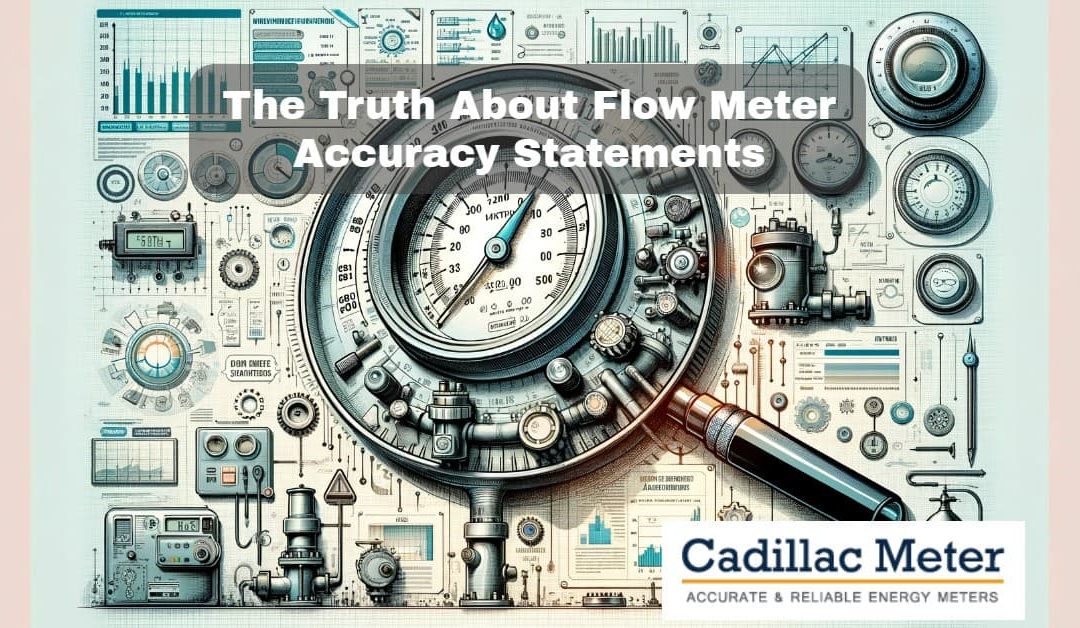Flow meter accuracy versus Flow meter turndown is a subject that gets very little attention, but has a huge impact on true measurement accuracy, especially under low flow conditions.
Typically accuracy statements are established under lab test conditions with NIST traceable instruments. These measurements are made under very controlled conditions and in most cases do not represent the real world when it comes to installation. In addition, when these test results are documented they are massaged in Marketing produced materials, which provide these results in a way to highlight advantages and hide limitations.
Accuracy is typically stated in two forms, (+/-) a percentage of rate or reading or (+/-) a percentage of full scale. The decision to use one over the other is essentially marketing driven. As an example, I have listed a typical specification for a turbine style meter to explain.
“Highly Accurate
NIST traceable factory calibration performed on every meter, within ±0.5% of reading accuracy at the calibrated (typical) flow velocity and within ±1-2% of reading over a 50:1 flow range.
Unequaled Operating Range
Provides repeatable flow data over a 175:1 turndown from 0.17 to 30 ft/s.”
If you notice they mix or separate accuracy statements with turndown to hide functional limitations.
1) Lets take the first statement
“Highly Accurate
NIST traceable factory calibration performed on every meter, within ±0.5% of reading accuracy at the calibrated (typical) flow velocity”
First, what is typical flow velocity? Most likely this is a very limited range in the (10 -15 ft/s) range, but who really knows since this statement has been massaged to make the meter seem to perform better than it every would in the field.
2) The next statement begins to shed some light on the real capability of the meter.
“and within ±1-2% of reading over a 50:1 flow range”
First, turndown is based upon the maximum velocity the meter is capable of operating. In this case if you look at the third statement you will see that is 30 ft/s. If you divide that by 50, which is the turndown they are using for this accuracy statement, they are stating the meter has a (+/-) 1-2% accuracy of reading down to (0.6 ft/s), which is a common flow velocity especially with modulating flows driven by VFD on pumps and modulating control valves on point of use systems. So now the meter has gone form a (+/-) 0.5% of rate device to (+/-) 1-2%.
3) The last statement is where the marketing really gets dicey.
“Unequaled Operating Range
Provides repeatable flow data over a 175:1 turndown from 0.17 to 30 ft/s.”
What does “Provides reliable flow data” mean? That the turbine is still turning? That there is some reading on the display? If this statement had any merit, it would make an accuracy statement with regard to this operating range. Otherwise this is a statement of no value and is nothing more than marketing gibberish.
To make matters worse most piping systems are designed for a maximum velocity not to exceed (15 Ft/s), since above this velocity the friction pressure losses through the piping itself is very prohibitive with regard to energy usage just in moving the media. Ideally these systems really want to operate at a maximum velocity of (5-10 Ft/s) to optimize system performance, while balancing expansion capability. Taking this into account if you now apply this to the turbine meter referenced above you can only make the following statement.
Since you do not know the calibrated velocity of the meter, since it is not stated anywhere, you can throw the (+/-) 0.5% of rate out completely. If you work backwards from the 0.6 ft/sec minimum flow based on the 50:1 turndown at 30 ft/s, you now have a meter with a 15:1 turndown at (0.6 ft/s) to (9 ft/sec) with an accuracy of (+/-) 1-2% of rate or reading. And knowing that the meter accuracy decreases with velocity due to flow profile changes and friction losses this is probably much closer to 2% than 1%.
So, in conclusion any reference or statement of (+/-) 0.5% accuracy is completely worthless. And we really have no idea what if any accuracy statement can be made below 0.6 ft/s. As a result, we are left with a (+/-) 2% meter, since they cannot differentiate where or when it goes from 1% to 2%, in a very limited operating range, which is not “Highly Accurate” or does it have an “Equaled Operating Range”, making all their statements effectively false and misleading.



